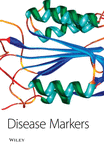Serum Soluble Vascular-Cell Adhesion Molecule-1 (VCAM-1) in Patients with Acute and Chronic Liver Diseases
Abstract
Our ai m was to ascertai n the degree of variation of serum soluble vascular cell adhesion moleculeI (VCAM-1) concentrations according to the nature and the severity of an underl ying liver disease . One-hundred forty sera collected from 123 patients (83 male, 40 female) with acute hepatitis (n=14). mi Id chronic Ii ver disease (n=52) or cirrhosis (n=57) of different etiologies as well as from 17 healthy blood donors (8 male, 9 female) were studied. Soluble VCAM-I concentration was measured immunoenzymatically. One-way analysis of variance revealed a significant variability of the mean values of soluble VCAM-1 among groups (F=80.02, p <0.000 I). All groups of patients had higher soluble VCAM-I than controls; moreover, patients with acute hepatitis and patients with cirrhosis had higher soluble VCAM-1 levels than patients with mild chronic liver disease (Bonferroni′s test. p <0.(1). These results did not change after stratification of patients according to the etiology (viral or toxic) of liver disease (two-way analysis of variance: grouping factor diagnosis, F=60.39, p <0.000 I; grouping factor etiology. F= 1.73, p NS). Cholinesterase, total bilirubin, circulating thrombocytes and blood urea nitrogen were the independent predictors of the concentration of soluble VCAM-1. In conclusion, patients with liver disease have high serum soluble VCAM-1, which seems to reflect more the severity of impairment of liver function rather than the etiologic nature of the disease.




